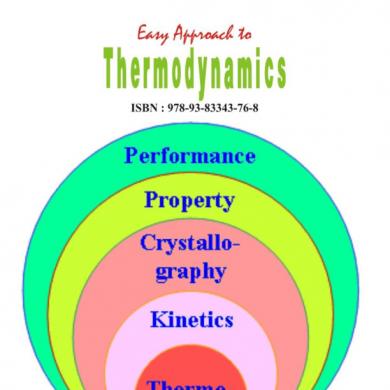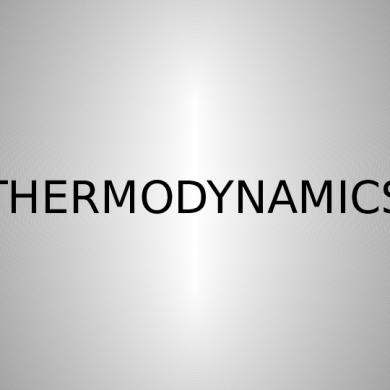Entropy Thermodynamics
This document was uploaded by user and they confirmed that they have the permission to share it. If you are author or own the copyright of this book, please report to us by using this DMCA report form. Report DMCA
Overview
Download & View Entropy Thermodynamics as PDF for free.
More details
- Words: 700
- Pages: 24
Loading documents preview...
Entropy Accompanying Phase Transition
The variation of entropy with temperature
To calculate dq, the heat capacity C is;
∆T is the change in temperature
Reversible: dqrev = CdT ;
Example • Calculate the change in molar entropy when hydrogen gas is heated from 20°C to 30°C at constant volume. (CV,m = 22.44 J K−1 mol−1)
• [Answer: +0.75 J K−1 mol−1]
THE ENTROPY CHANGE ACCOMPANYING A PHASE TRANSITION
The increase in entropy from solid to liquid to gas Absolute entropy increases steadily with increasing temperature until the melting point is reached, where it jumps suddenly as the substance undergoes a phase change from a highly ordered solid to a disordered liquid (ΔSfus). The entropy again increases steadily with increasing temperature until the boiling point is reached, where it jumps suddenly as the liquid undergoes a phase change to a highly disordered gas (ΔSvap).
Copyright © The McGraw-Hill Companies, Inc. Permission required for reproduction or display.
Entropy of fusion • The transfer of energy as heat occurs reversibly when a solid is at its melting temperature. • If the temperature of the surroundings is infinitesimally lower than that of the system, then energy flows out of the system as heat and the substance freezes. • If the temperature is infinitesimally higher, then energy flows into the system as heat and the substance melts.
• Transition occurs at constant pressure, the heat transferred per mole of substance with the enthalpy of fusion (melting).
Entropy of fusion, ΔfusS The change of entropy per mole of substance, at the melting temperature, Tf (with f now denoting fusion)
To get the standard entropy of fusion, Δfus S at the melting temperature we use the melting temperature at 1 bar and the corresponding standard enthalpy of fusion at that temperature.
Entropy of fusion, ΔfusS • All enthalpies of fusion are positive (melting is endothermic: it requires heat) • So all entropies of fusion are positive too: disorder increases on melting.
Example Calculate the standard entropy of fusion of ice at 0°C from the information in Table 3.1.
Solution From the Table;
∆fusH(0) = 6.01 kJ mol-1 ∆fusS = ∆fusH(Tf) / Tf = 6.01 kJ mol-1 / 273.15 K = 0.022 kJ K-1mol-1 = 22 J K-1 mol-1
Entropy of vaporization, ΔvapS • At the boiling temperature, Tb, of a liquid is related to its enthalpy of vaporization at that temperature by:
• To use this formula, we use the enthalpy of vaporization at the boiling temperature, Tb • For the standard value, ΔvapS , we use data corresponding to 1 bar.
Entropy of vaporization, ΔvapS • All entropies of vaporization are positive, because vaporization is endothermic
Exercise • Calculate the entropy of vaporization of water at 100°C.
• [Answer: +109 J K−1 mol−1]
Solution • First, calculate the entropy change for heating liquid water from 25°C to 100°C
• From Table 3.1, calculate the entropy of transition at 100°C.
• Calculate the change in entropy for cooling the vapour from 100°C to 25°C (with data for the vapour from Table 2.1)
• The sum of the three entropy changes is the entropy of transition at 25°C:
• The units of entropy are joules per kelvin (J K−1). • Entropy is an extensive property
• When we deal with molar entropy, an intensive property, the units will be joules per kelvin per mole (J K−1 mol−1).
• At ΔG < 0 the reaction tends to form more products. • At ΔG > 0, the reverse reaction is spontaneous, and the products tend to decompose into reactants. • Where ΔG = 0 (at the minimum of the graph where the slope is zero), the reaction has no tendency to form either products or reactants. • The reaction is at equilibrium. That is, the criterion for chemical equilibrium at constant T and P is ΔG = 0
REMEMBER!!!!! • ΔS > 0, for a spontaneous (irreversible) process • Δ S = 0, for a system at equilibrium (reversible) • Δ S < 0, cannot be
TRY THIS!!! Calculate the entropy of fusion of benzoic acid, where ΔHfus= 4320 cal mol-1 and Tm= 122.1°C.
[Answer: +45.73 J K-1 mol-1]
CAN ΔS NEGATIVE?????
ENTROPY AT CONSTANT PRESSURE
ENTROPY AT CONSTANT VOLUME
The variation of entropy with temperature
To calculate dq, the heat capacity C is;
∆T is the change in temperature
Reversible: dqrev = CdT ;
Example • Calculate the change in molar entropy when hydrogen gas is heated from 20°C to 30°C at constant volume. (CV,m = 22.44 J K−1 mol−1)
• [Answer: +0.75 J K−1 mol−1]
THE ENTROPY CHANGE ACCOMPANYING A PHASE TRANSITION
The increase in entropy from solid to liquid to gas Absolute entropy increases steadily with increasing temperature until the melting point is reached, where it jumps suddenly as the substance undergoes a phase change from a highly ordered solid to a disordered liquid (ΔSfus). The entropy again increases steadily with increasing temperature until the boiling point is reached, where it jumps suddenly as the liquid undergoes a phase change to a highly disordered gas (ΔSvap).
Copyright © The McGraw-Hill Companies, Inc. Permission required for reproduction or display.
Entropy of fusion • The transfer of energy as heat occurs reversibly when a solid is at its melting temperature. • If the temperature of the surroundings is infinitesimally lower than that of the system, then energy flows out of the system as heat and the substance freezes. • If the temperature is infinitesimally higher, then energy flows into the system as heat and the substance melts.
• Transition occurs at constant pressure, the heat transferred per mole of substance with the enthalpy of fusion (melting).
Entropy of fusion, ΔfusS The change of entropy per mole of substance, at the melting temperature, Tf (with f now denoting fusion)
To get the standard entropy of fusion, Δfus S at the melting temperature we use the melting temperature at 1 bar and the corresponding standard enthalpy of fusion at that temperature.
Entropy of fusion, ΔfusS • All enthalpies of fusion are positive (melting is endothermic: it requires heat) • So all entropies of fusion are positive too: disorder increases on melting.
Example Calculate the standard entropy of fusion of ice at 0°C from the information in Table 3.1.
Solution From the Table;
∆fusH(0) = 6.01 kJ mol-1 ∆fusS = ∆fusH(Tf) / Tf = 6.01 kJ mol-1 / 273.15 K = 0.022 kJ K-1mol-1 = 22 J K-1 mol-1
Entropy of vaporization, ΔvapS • At the boiling temperature, Tb, of a liquid is related to its enthalpy of vaporization at that temperature by:
• To use this formula, we use the enthalpy of vaporization at the boiling temperature, Tb • For the standard value, ΔvapS , we use data corresponding to 1 bar.
Entropy of vaporization, ΔvapS • All entropies of vaporization are positive, because vaporization is endothermic
Exercise • Calculate the entropy of vaporization of water at 100°C.
• [Answer: +109 J K−1 mol−1]
Solution • First, calculate the entropy change for heating liquid water from 25°C to 100°C
• From Table 3.1, calculate the entropy of transition at 100°C.
• Calculate the change in entropy for cooling the vapour from 100°C to 25°C (with data for the vapour from Table 2.1)
• The sum of the three entropy changes is the entropy of transition at 25°C:
• The units of entropy are joules per kelvin (J K−1). • Entropy is an extensive property
• When we deal with molar entropy, an intensive property, the units will be joules per kelvin per mole (J K−1 mol−1).
• At ΔG < 0 the reaction tends to form more products. • At ΔG > 0, the reverse reaction is spontaneous, and the products tend to decompose into reactants. • Where ΔG = 0 (at the minimum of the graph where the slope is zero), the reaction has no tendency to form either products or reactants. • The reaction is at equilibrium. That is, the criterion for chemical equilibrium at constant T and P is ΔG = 0
REMEMBER!!!!! • ΔS > 0, for a spontaneous (irreversible) process • Δ S = 0, for a system at equilibrium (reversible) • Δ S < 0, cannot be
TRY THIS!!! Calculate the entropy of fusion of benzoic acid, where ΔHfus= 4320 cal mol-1 and Tm= 122.1°C.
[Answer: +45.73 J K-1 mol-1]
CAN ΔS NEGATIVE?????
ENTROPY AT CONSTANT PRESSURE
ENTROPY AT CONSTANT VOLUME
Related Documents

Entropy Thermodynamics
January 2021 4
Thermodynamics
January 2021 1
Thermodynamics
January 2021 1
Thermodynamics
January 2021 2
Thermodynamics
January 2021 3
Thermodynamics
January 2021 3More Documents from "snehaeslate"
